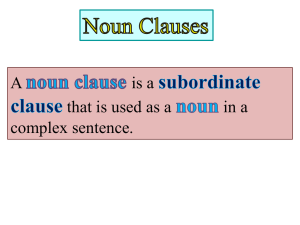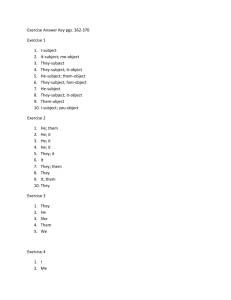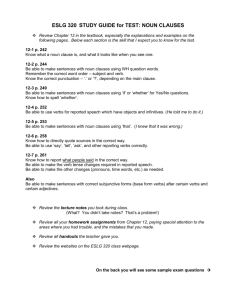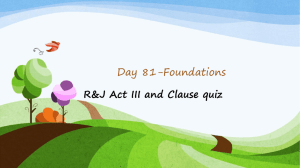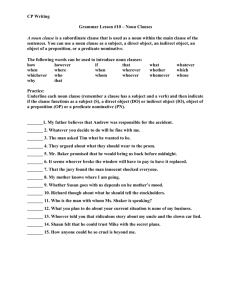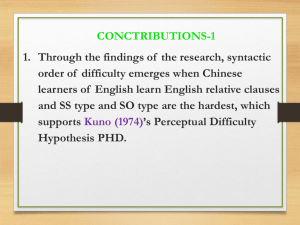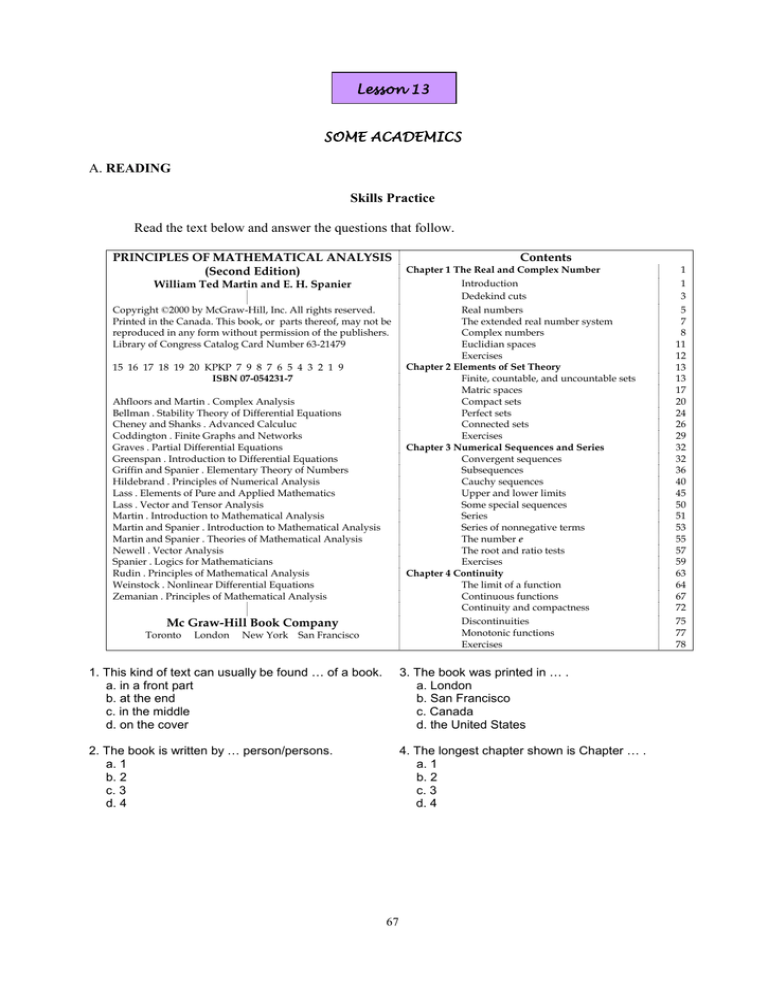
Lesson 13
SOME ACADEMICS
A. READING
Skills Practice
Read the text below and answer the questions that follow.
PRINCIPLES OF MATHEMATICAL ANALYSIS
(Second Edition)
William Ted Martin and E. H. Spanier
Copyright © 2000 by McGraw-Hill, Inc. All rights reserved.
Printed in the Canada. This book, or parts thereof, may not be
reproduced in any form without permission of the publishers.
Library of Congress Catalog Card Number 63-21479
15 16 17 18 19 20 KPKP 7 9 8 7 6 5 4 3 2 1 9
ISBN 07-054231-7
Ahfloors and Martin . Complex Analysis
Bellman . Stability Theory of Differential Equations
Cheney and Shanks . Advanced Calculuc
Coddington . Finite Graphs and Networks
Graves . Partial Differential Equations
Greenspan . Introduction to Differential Equations
Griffin and Spanier . Elementary Theory of Numbers
Hildebrand . Principles of Numerical Analysis
Lass . Elements of Pure and Applied Mathematics
Lass . Vector and Tensor Analysis
Martin . Introduction to Mathematical Analysis
Martin and Spanier . Introduction to Mathematical Analysis
Martin and Spanier . Theories of Mathematical Analysis
Newell . Vector Analysis
Spanier . Logics for Mathematicians
Rudin . Principles of Mathematical Analysis
Weinstock . Nonlinear Differential Equations
Zemanian . Principles of Mathematical Analysis
Mc Graw-Hill Book Company
Toronto
London
New York
San Francisco
Contents
Chapter 1 The Real and Complex Number
Introduction
Dedekind cuts
Real numbers
The extended real number system
Complex numbers
Euclidian spaces
Exercises
Chapter 2 Elements of Set Theory
Finite, countable, and uncountable sets
Matric spaces
Compact sets
Perfect sets
Connected sets
Exercises
Chapter 3 Numerical Sequences and Series
Convergent sequences
Subsequences
Cauchy sequences
Upper and lower limits
Some special sequences
Series
Series of nonnegative terms
The number e
The root and ratio tests
Exercises
Chapter 4 Continuity
The limit of a function
Continuous functions
Continuity and compactness
Discontinuities
Monotonic functions
Exercises
1. This kind of text can usually be found … of a book.
a. in a front part
b. at the end
c. in the middle
d. on the cover
3. The book was printed in … .
a. London
b. San Francisco
c. Canada
d. the United States
2. The book is written by … person/persons.
a. 1
b. 2
c. 3
d. 4
4. The longest chapter shown is Chapter … .
a. 1
b. 2
c. 3
d. 4
67
1
1
3
5
7
8
11
12
13
13
17
20
24
26
29
32
32
36
40
45
50
51
53
55
57
59
63
64
67
72
75
77
78
5. The shortest chapter shown is Chapter … .
a. 1
b. 2
c. 3
d. 4
9. The book with this title has been written by …
other writers.
a. 1
b. 2
c. 3
d. 4
6. All chapters have … .
a. an introduction
b. elements
c. a closing
d. exercises
10. The subjects of continuity and discontinuity are
discussed in Chapter … .
a. 1
b. 2
c. 3
d. 4
7. Altogether, the writers of this book have written …
books.
a. 1
b. 2
c. 3
d. 4
11. Most probably, the next page would be about … .
a. real and complex numbers
b. theory of sets
c. sequences and series
d. continuity and discontinuity
8. The international book number is … .
a. 2000
b. 63-21479
c. 15 16 17 18 19 20 KPKP 7 9 8 7 6 5 4
3 2 1 9
d. 07-054231-7
12. The term all rights reserved means that this
book is … .
a. fine
b. not for sale
c. complete
d. copy-righted
B. VOCABULARY
Abbreviations and Others
Exercise 1
Match the abbreviations in the left column with their corresponding explanation in the right. Check
with your dictionary to help you.
1. ISBN
2. FAO
3. TKO
4. RSVP
5. VIP
6. OPEC
7. EEC
8. UFO
9. BBC
10. SOS
11. SAR
12. GATT
13. GMT
14. RIP
15. COD
Lesson 13
A. international time
B. international book number
C. international organization related to food
D. flying in space
E. payment at home
F. radio broadcasting station
G. European organization related to economy
H. a term in boxing or fighting sports
I. international agreement on tariffs and trade
J. dead
K. team to search and help troubled people
L. international oil organization
M. very special persons
N. answer please
O. please help us
68
Exercise 2
Match the abbreviations in the left column with their corresponding meaning in the right. Check
with your dictionary to help you.
1. Inc.
2. et. al.
3. etc.
4. a.m.
5. e.g.
6. Ltd.
7. i.e.
8. cf.
9. pto
10. vs.
a. that is, namely
b. compare
c. company
d. in the morning
e. against
f. please turn over
g. limited
h. and others
i. and so on
j. for example
Exercise 3
Match the symbols in the left column with their corresponding meaning in the right. Check with
your dictionary or other reference books.
1. #
2. &
3. !
4. ©
5.
6. >
7. ¶
8.
9.
10.
a. more than
b. cut here
c. information
d. watch out
e. sum, total
f. number
g. and
h. unlimited amount
i. new paragraph
j. copy right
C. GRAMMAR
Content Clauses
We often meet this type of sentences:
I understand that I must return the books on time.
She said that she was leaving for the holiday.
We know where he lives.
In the grammar of a language, these sentences are called content clauses or noun clauses.
Remember that we have studied adjective clauses in the lesson about noun phrases. Sometimes, it is
necessary to be able to differentiate between these two constructions.
Adjective clauses are those which function as qualifiers of a head word. A noun clause, however,
functions as a noun. It stands by itself as a noun. It does not qualify another noun.
We also have studied about the forms and functions of nouns. Nouns can be subjects, objects, or
complements in sentences. They can also come after prepositions. The same thing can happen to noun
clauses. Noun clause can be subjects, objects, or complements of sentences. They can also become objects of
prepositions. Study the following examples.
Lesson 13
69
Function
Subject
Object
Complement
Object to preposition
Examples
Who finishes first will get a present.
What goes up must come down.
They think that the test is on the next day.
You may decide what time you want to go.
Love is what you can give.
It seems what it looks.
We talked about what it seemed to be the right solution.
You can speak to whoever you meet first.
As we have learned earlier, again, this construction is not a question form. It is a sub-ordinate clause.
It has the grammar of a positive sentence, not an interrogative sentence. Compare these below?
(1) What time do you want to go?
(do) + inversion
question mark
(2) You may decide what time you want to go.
no inversion
no question mark
In the first sentence, (1), we have the rules for forming the question: the use of the auxiliary do, the
inversion of the subject and predicate, and the question mark at the end of the question. But in the second
sentence, (2), we do not have the interrogative rules. It is an ordinary affirmative sentence. Look again:
(1)
… what time do you want to go?
(2)
… what time you want to go.
Exercise 1
Identify which one is the noun clause.
1. a) I like the book that you bought for me yesterday.
b) They know that you bought a book for me yesterday.
2. a) The director has made an announcement that makes everybody worried.
b) The director has announced what makes everybody worried.
3. a) I can decide wherever I want to go.
b) I made a decision that made everybody surprised.
4. a) The students spoke to the person who was responsible for the event.
b) The students have spoken to who is supposed to be responsible for the event.
5. a) Somebody please tell me about what has happened here?
b) Somebody has told me about the accident that happened here.
Lesson 13
70
Exercise 2
Change these into sentences that have a noun clause like the ones above.
1. The teacher asked: ”What do you want?”
2. He said: “None of my friends would want to come with me.”
3. The secretary understands his jobs well. (The secretary understands what …)
4. She promised: “You will get a nice birthday present.”
5. The manager explains something the company is going to do. (The manager explains what …)
6. I asked the shopkeeper: “How much does a second-hand monitor unit cost?”
7. They explained the reason for cancelling the show. (They explained why …)
8. Somebody at the back shouted: “I don’t agree with your opinion.”
9. We know the person who will become a good leader.
10. My friend answered: “I came late because I had a flat tire.” (My friend answered why …)
Lesson 13
71

